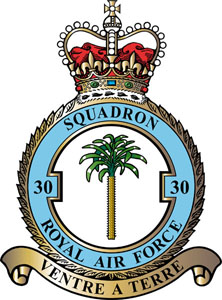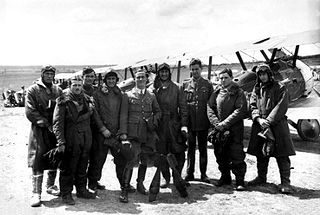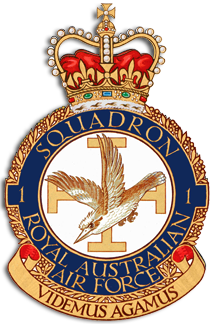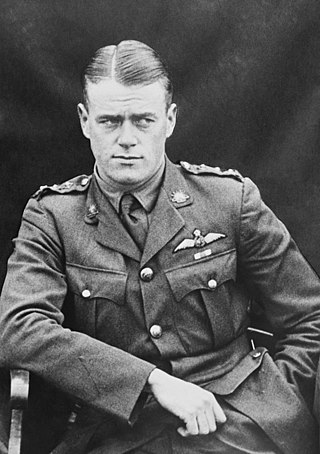
Number 30 Squadron of the Royal Air Force operates the Airbus A400M Atlas transport aircraft and is based at RAF Brize Norton, Oxfordshire.

The Australian Flying Corps (AFC) was the branch of the Australian Army responsible for operating aircraft during World War I, and the forerunner of the Royal Australian Air Force (RAAF). The AFC was established in 1912, though it was not until 1914 that it began flight training.

No. 1 Squadron is a Royal Australian Air Force (RAAF) squadron headquartered at RAAF Base Amberley, Queensland. It is controlled by No. 82 Wing, part of Air Combat Group, and is equipped with Boeing F/A-18F Super Hornet multi-role fighters.

No. 5 Squadron was a Royal Australian Air Force training, army co-operation and helicopter squadron. The squadron was formed in 1917 as a training unit of the Australian Flying Corps in Britain, readying pilots for service on the Western Front. It subsequently became a naval fleet co-operation squadron, but was later redesignated as No. 9 Squadron RAAF before being re-formed as an army co-operation squadron during World War II. In the mid-1960s, it was re-formed as a helicopter squadron, before being disbanded in December 1989, when it was used to form the Australian Defence Force Helicopter Training School.

Central Flying School (CFS) is a Royal Australian Air Force (RAAF) training unit, located at RAAF Base East Sale, Victoria. It operates the Pilatus PC-21 turboprop trainer. The school is responsible for training flight instructors, setting flying standards, and auditing flying practices. It is also home to the "Roulettes" aerobatic team. CFS was the first military aviation unit to be formed in Australia, in 1913, when its role was to provide basic flying training. Its current form dates from World War II, when it was re-established to train flying instructors for the Empire Air Training Scheme (EATS).

Elwyn Roy King, DSO, DFC was a fighter ace in the Australian Flying Corps (AFC) during World War I. He achieved twenty-six victories in aerial combat, making him the fourth highest-scoring Australian pilot of the war, and second only to Harry Cobby in the AFC. A civil pilot and engineer between the wars, he served in the Royal Australian Air Force (RAAF) from 1939 until his death.

The Maurice Farman MF.7 Longhorn is a French biplane developed before World War I which was used for reconnaissance by both the French and British air services in the early stages of the war before being relegated to service as a trainer.

The Maurice Farman MF.11 Shorthorn is a French aircraft developed before World War I by the Farman Aviation Works. It was used as a reconnaissance and light bomber during the early part of World War I, later being relegated to training duties.

Walter Oswald Watt, was an Australian aviator and businessman. He served as a pilot during World War I with, firstly, the French Foreign Legion and, secondly, the Australian Flying Corps (AFC).

Sir Thomas Walter White, was an Australian politician and pilot in the First World War. In 1914 he became one of the first airmen trained for the Australian Flying Corps (AFC), and the following year he was among the first AFC members to see action when he was deployed to the Middle East with the Mesopotamian Half Flight. After carrying out several missions behind Turkish lines, he was captured in November 1915 but escaped in July 1918. White was awarded the Distinguished Flying Cross and twice mentioned in despatches for his war service. He married Vera Deakin, a Red Cross worker and daughter of former Australian Prime Minister Alfred Deakin, in 1920.

The 1st Australian Wireless Signal Squadron was a unit of the Australian Imperial Force (AIF) which served in Mesopotamia during World War I. Formed in late 1915, it took part in the Mesopotamian Campaign from 1916 to 1918, providing communications to British forces. Later, elements of the squadron served as part of Dunsterforce in 1918 and 1919, and in Kurdistan in 1919. The unit was also known as the 1st Wireless Signal Squadron and 1st Australian and New Zealand Signal Squadron.

Garnet Francis Malley, was an Australian fighter ace of World War I, credited with six aerial victories. He was an aviation adviser to Chiang Kai-shek's government in China during the 1930s, and an intelligence officer in World War II.

Henry Aloysius Petre, DSO, MC was an English solicitor who became Australia's first military aviator and a founding member of the Australian Flying Corps, the predecessor of the Royal Australian Air Force. Born in Essex, Petre forsook his early legal career to pursue an interest in aviation, building his own aeroplane and gaining employment as an aircraft designer and pilot. In 1912, he answered the Australian Defence Department's call for pilots to form an aviation school, and was commissioned as a lieutenant in the Australian Military Forces. The following year, he chose the site of the country's first air base at Point Cook, Victoria, and established its inaugural training institution, the Central Flying School, with Eric Harrison.

Eric Harrison was an Australian aviator who made the country's first military flight, and helped lay the foundations of the Royal Australian Air Force (RAAF).

Air Vice-Marshal George John William Mackinolty, OBE was a senior commander in the Royal Australian Air Force (RAAF). Commencing his service in the Australian Flying Corps (AFC) as a mechanic during World War I, he rose to become the RAAF's chief logistics officer for more than twenty years. Mackinolty was born in Victoria and joined the AFC in 1914. He first saw active duty the following year in the Middle East with No. 30 Squadron Royal Flying Corps. In 1916 he was mentioned in despatches and posted to No. 2 Squadron AFC. By the end of the war he had been commissioned a second lieutenant.

Thomas Charles Richmond Baker, was an Australian soldier, aviator, and flying ace of the First World War. Born in Smithfield, South Australia, he was an active sportsman in his youth and developed a keen interest in aviation. He was employed as a clerk with the Bank of New South Wales, before he enlisted in the Australian Imperial Force in July 1915, for service in World War I. Posted to an artillery unit on the Western Front, he was awarded the Military Medal for carrying out numerous repairs on a communications line while subject to severe artillery fire. In June 1917, Baker was awarded a bar to his decoration for his part in quelling a fire in one of the artillery gun pits that was endangering approximately 300 rounds of shrapnel and high explosive.

Roy Cecil Phillipps, MC & Bar, DFC was an Australian fighter ace of World War I. He achieved fifteen victories in aerial combat, four of them in a single action on 12 June 1918. A grazier between the wars, he joined the Royal Australian Air Force (RAAF) in 1940 and was killed in a plane crash the following year.

Leslie Hubert Holden, MC, AFC was an Australian fighter ace of World War I and later a commercial aviator. A South Australian, he joined the Light Horse in May 1915, serving in Egypt and France. In December 1916, he volunteered for the Australian Flying Corps and qualified as a pilot. As a member of No. 2 Squadron on the Western Front, he gained the sobriquets "Lucky Les" and "the homing pigeon" after a series of incidents that saw him limping back to base in bullet-riddled aircraft. He was awarded the Military Cross, and went on to achieve five aerial victories flying Airco DH.5s and Royal Aircraft Factory S.E.5s.
William Wallace Allison Burn was a New Zealand aviator, who served with the New Zealand Military Forces during the First World War.

Lieutenant-Colonel Edgar Hercules Reynolds OBE commanded the Australian Flying Corps (AFC) during World War I. Reynolds' role was mostly administrative, as AFC squadrons were usually subordinate to Australian ground forces or British air commands.

















